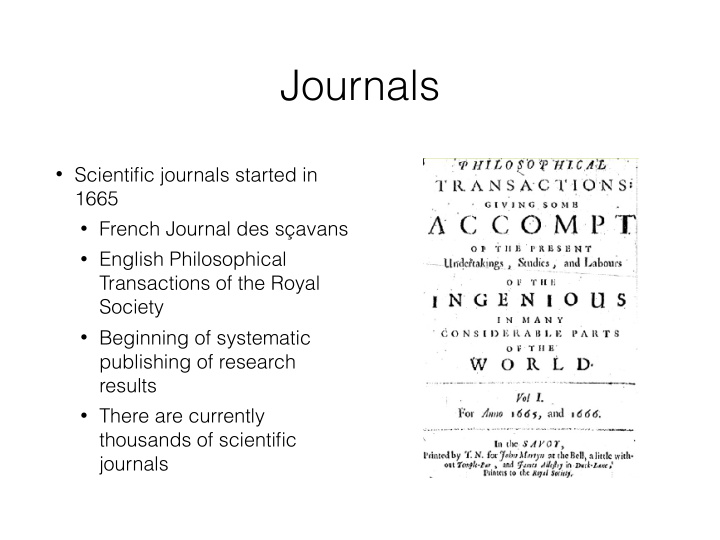



Journals • Scientific journals started in 1665 • French Journal des sçavans • English Philosophical Transactions of the Royal Society • Beginning of systematic publishing of research results • There are currently thousands of scientific journals
Journals • A scientific/academic journal is a: • “[...] peer-reviewed periodical in which scholarship relating to a particular academic discipline is published. Academic journals serve as forums for the introduction and presentation for scrutiny of new research, and the critique of existing research. Content typically takes the form of articles presenting original research, review articles, and book reviews” • Source: Wikipedia at http://en.wikipedia.org/wiki/ Academic_journal
Journals • Academic articles have two roles • Link authors to readers interested in their field • Peer-review of work by experts in the area • Most scientific fields use journals for publishing • Computing is somewhat an exception
Conferences & Workshops • Scientists meet and exchange ideas • Conference/workshop normally consists of • Oral presentations of paper • Questions and answers • Published proceedings (often alternative to journal in Computing) • Papers may be shepherded • Author is assigned a shepherd – less adversarial
Conferences & Workshops • Workshops also popular form of conferences • Tend to be more collaborative or interactive • e.g. New Security Paradigms Workshop (NSPW) – www.nspw.org • Proceedings may be published in electronic form only • Association for Computing Machinery’s Digital Library • IEEE Xplore Digital Library
Conferences Submission Process • Programme chair selects programme committee • Call for papers is distributed • Area(s) of interest • Paper format • Anonymous (blind) or not anonymous • Dates • Submission date • Notification date • Proceedings/Pre-proceedings date • Conference date(s) • Post-proceedings deadline (if applicable)
Conferences Submission Process • Call for papers – see Moodle for examples • WikiCFP - http://www.wikicfp.com/cfp/ Make sure you are aware of the main focus of the conference!
Conferences Submission Process • Authors submit papers by submission date • Programme chair assigns submitted papers to members of programme committee • Usually 2–4 reviews per paper • Rules for conflicts of interest • A programme committee member may forward paper to external reviewer with more expertise • Once all reviews carried out programme committee discusses which to accept • Usually 20-40% of submitted papers
Acceptance Rate NSPW
Acceptance Rate CHI
Acceptance Rate STOC
Conferences Submission Process • Reviews • Succinct (1/2 page) • Anonymous (usually) • Sometimes double-blind – authors anonymous • May need to redact certain phrases to maintain anonymity • Contains comments for program committee and comments for authors • Authors may or may not take comments into account before submitting final version for publication • However, problem with submission date extensions!
Conferences Submission Process • Reviews • Usually include • Summary of paper (e.g. problem, results, conclusions) • Contribution made • Sometimes only interested in main contribution • Strengths and weaknesses • Areas for improvement • Other references which could be followed up • Maybe comments about readability, style, length • Decision - Strong/Weak Accept/Reject • This is your one page paper review
Journal Submission Process • In computer science not used so frequently • Mostly for major results and additional validation • In computer science can submit conference proceedings to journal afterwards • More elaborate review process • Paper assigned to associate editor who selects reviewers (usually two) • Usually more thorough reviews • Lengthier submission process (can take years) • May have several rounds of revisions
Hybrid Journal/Conference • Submission process similar to conference but multiple opportunities to submit • Usually regular deadlines • Sometimes can submit at any time • Conference style program committee reviews papers • Outcome may be accept, reject, or resubmit to future issue • Accepted papers published throughout year
Which Papers Are Accepted? • A good paper is: • Great, novel idea - major step forward • Thorough work and documentation • Good adherence to scientific method (if applicable) • Well written and easy to understand • A bad paper is: • Not such an interesting, new idea – small progress • Repeat of previous work • Poor adherence to scientific method (if applicable) • Poorly written • Reality = many in between good and bad
Review Process May Not Be Perfect • Ideally reviewer is expert in the topic and checks all details thoroughly, but • Paper may be assigned to wrong reviewer • No expert available • Lack of time • A reviewer may have 30 papers to read • (+lecturing, research, writing their own papers, meetings...) • More reviewers to catch errors in judgement • Sometimes reviewers disagree • Remember shortcomings in peer review process
Authors May Not Be Perfect • Authors have other goals • May not be seeking truth and doing good science • Hiring, promotions, grants, money... • Pressure from mantra of “publish or die” • Biased authors • Authors may oversell or manipulate results • Balancing effects • Reviewers
Academic Dishonesty – Recent Allegations
Still Better Than Alternative • Scientific Article • Provides data/evidence for claims • Peer-reviewed • Open to scrutiny and verification by readers • Compare with • Commercial publications • Beware vendors’ white papers • Newspaper and magazine articles • Drama and exaggeration sells more newspapers
Recommend
More recommend